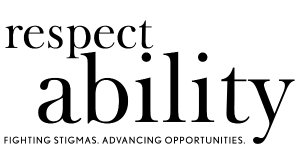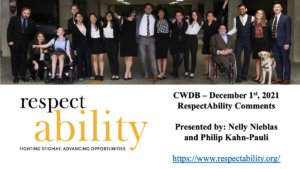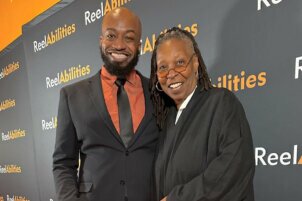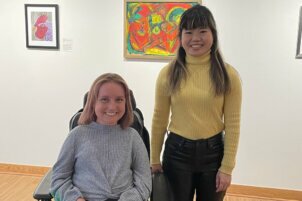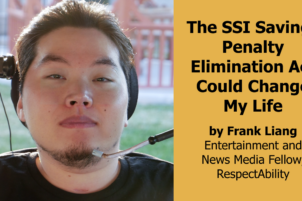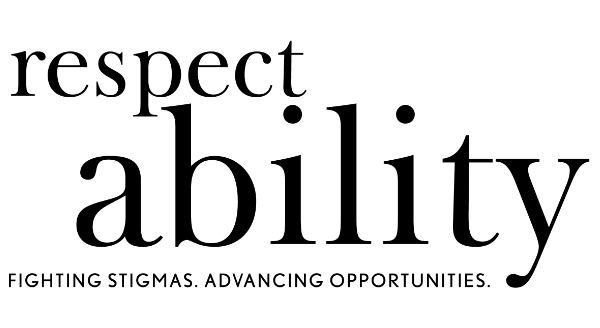Sacremento, CA, December 1 – This week, the California Workforce Development Board met to discuss the status of workforce practices in the Golden State. In response to this meeting, RespectAbility, a national, non-partisan nonprofit organization, submitted testimony on how to implement best practices, advocate for greater inclusion and improve the standing of people with disabilities in the workforce.
“When it was passed with broad, bipartisan support in 2014, the Workforce Innovation and Opportunity Act (WIOA) invested unprecedented resources into efforts to get people with barriers to employment into the labor force,” said Olegario “Ollie” Cantos VII, RespectAbility’s Chairman. “Now, after the pandemic that has reshaped our economy, it is time to devote significant attention to supporting the economic advancement of students, job-seekers, and entrepreneurs with disabilities.”
There are more than 1.9 million working age (18-64) Californians living with some form of disability. Before the pandemic, 38.2 percent of the working age population of people with disabilities were employed. It is critical that California’s state workforce board listen to the individuals with disabilities and advocates impacted by these unemployment rates. In order to make the workforce more inclusive, and to find practical ways to make the workforce more accessible for the entire population, RespectAbility collects, summarizes, and publicizes ideas on key workforce solutions. To learn more about RespectAbility’s advocacy work, please visit our Policy website.
RespectAbility’s full testimony is presented online and below:
To: Members and Staff, California Workforce Development Board
From: Staff, Board, and Fellows of RespectAbility
Re: Public Comments for December 1, 2021 Meeting
Dear Chair Farooq, Ph.D. and Executive Director Rainey,
Thank you very much for the opportunity to offer our comments for the California Workforce Development Board (CWDB)’s December 1st meeting. Based in Los Angeles, RespectAbility is a nonpartisan, nonprofit disability inclusion organization dedicated to fighting stigmas and advancing opportunities for millions of Americans with disabilities.
The primary focus of our comments is to make sure that in this time of Build Back Better, as California pushes to transform the post-COVID workforce with High Road Jobs, CWDB is ready to serve the more than 4 million residents living with some form of disability, almost 11 percent of the state’s population. This data is almost certainly underreported, as the US Census Bureau tells us that the real number is around one in five Americans. Out of that number, there are 2,217,128 Black, Indigenous, and People of Color (BIPOC) people with disabilities. That means that 53 percent of all Californians with disabilities are also members of other marginalized communities and face barriers such as systemic racism.
More importantly, prior to the pandemic, California’s employment rate for working-age people with disabilities was 38.2 percent, compared to 76.4 percent of people without disabilities. This disparity is even more striking when broken down by race. 39.8 percent of working-age people with disabilities who are white have jobs compared to only 29.8 percent of those who are Black and 40.1 percent of those who are Hispanic/LatinX.
In these comments, RespectAbility team of subject matter experts and advocates with disabilities have collected our critical ideas, policy proposals, and key data to inform your board’s decision-making process. We are eager to collaborate with you and your team.
Our ideas and recommendations are as follows:
Encouraging More Private Sector Employers to Hire Workers with Disabilities
Given the tremendous demand for workers in the labor force and the increasing labor force participation rates among working-age people with disabilities, now is an ideal moment for workforce development leaders to reach out to private sector partners about disability employment best practices. First up, employers should be aware of and capitalize on the value of the Work Opportunity Tax Credit (WOTC) and Disabled Access Credit offered by the federal government. More details about the value and impact of those tax credits are available through the U.S. Department of Labor.
Likewise, private sector employers need to look at the successful inclusion practices of companies like JP Morgan Chase, Coca-Cola, UPS, EY, IBM, Walgreens, Starbucks, and SAP. Each of these employers are case studies that show people with disabilities can succeed. Accenture completed a major study that shows that such companies have seen “28 percent higher revenue, double the net income, and 30 percent higher economic profit margins” over a four-year period. That’s because people with disabilities bring unique characteristics and talents to the workplace that benefit employers and organizations. If we find the right jobs for the right people, it can and will increase the bottom line of companies.
Given the unprecedented situation created by the COVID-19 pandemic and economic crisis, new ideas, new efforts and new leadership are needed to remake the economy and make it more inclusive for all. Our community has been hit hard by the pandemic and needs to be at the forefront of any recovery efforts.
Capitalizing on Best Practices around Inclusive Apprenticeships, Subsidized Employment and On-The-Job-Training for Workers with Disabilities
Expanding post-secondary training programs and industry recognized credentials has been a signature goal of the past 6 years under the Workforce Innovation and Opportunity Act (WIOA) of 2014. There are now more apprenticeships than ever before, more subsidized employment programs, and more options for workers to “earn while they learn.” Critically, there are now also a body of proven or emerging best practices when it comes to promoting inclusion for workers with disabilities through apprenticeship programs. Over the past several years, the U.S. Department of Labor’s Office of Disability Employment Policy has documented great success through the Apprenticeship Inclusion Models (AIM). Completed in partnership with industry leaders like Amazon and Microsoft, this model generated real world data and experience on using apprenticeship programs to create a credentialing pipeline for workers with disabilities. Likewise, projects in diverse states such as Wisconsin, Pennsylvania, New Jersey, Ohio, Michigan and Virginia have proven strategies for expanding inclusive apprenticeships.
Subsidized employed is another strategy that shows potential for further investment, expansion and improvement. As captured in an October 2020 report from the Center on Law and Social Policy (CLASP), “subsidized employment uses public funds to create jobs for unemployed or underemployed workers, either through public sector jobs or wage subsidies paid directly to employers.” This model could have a significant impact in places like Los Angeles County where local government is a significant employer with various talent pipelines and labor needs. As noted by CLASP, not only can subsidized employment programs be expanded by leveraging both federal workforce dollars and local funding, it can also be a pathway for addressing racial equity issues, promoting quality jobs and addressing populations with specific barriers to employment. For example, youth, immigrants, returning citizens, and English language learners could all directly benefit from these types of programs. In fact, Los Angeles has historical experience with the impact subsidized employment projects can have on program participants. At the start of the last decade, the Los Angeles County Department of Public Social Services (DPSS) received stimulus funding to launch an innovative Transitional Subsidized Employment Program—Paid Work Experience (PWE). Past precedent can inform future work.
Lastly, On-the-Job Training (OJT) is another major priority for state and local workforce systems under WIOA. States have been actively collaborating to study, implement, and improve OJT programs. The National Conference of State Legislatures (NCSL) and the Council of State Governments (CSG) have documented the benefits that these programs can have for youth with disabilities and these examples merit your attention.
Use Online, Cohort-Based Apprenticeships to Train Workers with Disabilities for “High Road Jobs”
The pandemic has made remote work an accepted reality for thousands of workers. This has been a “silver lining” of expanding and normalizing a common reasonable accommodation request long championed by workers with disabilities. Microsoft has dramatically expanded their accessibility features, including built-in speech to text technology which makes it possible for people with even the most limited mobility to use computers. This has opened an unprecedented window for people with disabilities to contribute to the success of nonprofits, communities and beyond. Remote work also has great promise at expanding apprenticeship programs into more diverse sectors of the Washington state economy, especially the knowledge economy. RespectAbility has retooled our own National Leadership Program from being a cohort-based internship program located in Washington D.C., into an all-virtual, work-from-anywhere skills-based training program. This approach to virtual, cohort-based training has critical implications for future planning efforts around “high road jobs” and emerging sectors of the economy that put a priority on professional knowledge or technical skill. This is also a cost-effective approach because you are providing training to more than one recipient at a time, rather than taking a time/labor intensive one-on-one approach. Lastly, given the tremendous demand for entry level workers in various customer facing sectors of the economy, it is still critical to think about long-term career pathways and high-paying jobs for workers with disabilities in the future.
Adopting a State-wide Common Application Form to Connect Jobseekers With and Without Disabilities to Workforce Services
The economic challenges and massive job losses seen across the country last year brought much needed attention to gaps in existing labor systems. One such gap is in how people in need of support access and navigate workforce services. CalJobs has done much to encourage coordinated access to services, but there is still a need for having a single, common, and accessible state-wide application form in order to access workforce services. Other states and localities have successfully experimented have a common form to access everything from pre-employment transition services to apprenticeships to other credentialing programs.
The best example of successfully implement this type of approach is the No Wrong Door (NWD) System initiative previously conducted by the Administration for Community Living (ACL). While ACL’s work on creating a “No-Wrong-Door” system was specifically done around long-term services and support (LTSS) for older Americans and people with disabilities, this approach can significantly streamline bureaucratic processes, improve services, and support participant success. While there are barriers created by the legislative framework that funds and supports workforce services, pushing for greater collaboration at the state level and looking closely at user experience at the local level suggests that making the workforce system more person-centered and streamlined will reap critical benefits. More details and key lessons learned are well document by both Federal agencies and in other municipalities. As such, we encourage your team to learn more here:
- https://acl.gov/programs/connecting-people-services/aging-and-disability-resource-centers-programno-wrong-door
- https://dds.dc.gov/page/full-no-wrong-door-mission-vision
- https://dds.dc.gov/page/no-wrong-door
Focus on Closing the Gap in Labor Force Participation Rates between people with and without disabilities in California
As California grapples with strategies to get more Californians back to work, it is worth recognizing the good and bad news facing workers with disabilities. The bad news is that even before COVID-19, working-age Californians with disabilities lagged behind their non-disabled peers in job opportunities. and percent of those who are AAPI. Compounding the problem, the pandemic has ravaged the disability community and more than 1 million workers with disabilities have lost their jobs nationwide. Further, given your board’s scope of work impacting Californians in all parts of the state, it is worth noting that there are geographic differences in disability data and employment outcomes. Naturally, Los Angeles is home to the largest number of working-age people with disabilities in California with 466,385 Angelenos, among whom only 36.3 percent have jobs. At the same time San Mateo, Orange, and Contra Costa Counties all have higher disability employment rates. While they are significantly smaller than Los Angeles, the regional planning components of WIOA encounter workforce leaders to consider how to learn from regional differences and improve outcomes. More localized county-by-county data is available from the Annual Disability Statistics Compendium published by the Institute on Disability: https://disabilitycompendium.org/
Far too many decision-makers only pay attention to the overall unemployment rate without looking deeper. People with disabilities want to work, can work, and are striving to work harder than ever before. As such, RespectAbility has consistently advocated that decision-makers in the workforce development system at the national and local levels use the Labor Force Participation Rate as a key metric for measuring efforts to get more people with barriers to employment into the workforce. In the autumn of 2021, the labor force participation rate for working-age people with disabilities is now 2 full percentage points higher than it was before COVID-19. This means that people with disabilities are engaging with the labor force in higher numbers than before the pandemic. According to the Bureau of Labor Statistics, people with disabilities now have a 35.6 percent labor force participation rate, compared to 76.1 percent of those without disabilities.As such, decision making entities like your workforce board need to adopt a focused strategy for getting more people with disabilities into the workforce and the right metrics to hold themselves accountable for that success.
Improving the Workforce Impact of Community Colleges and Helping Students with Disabilities to Succeed
Community colleges are crucial pieces of the nation’s workforce development infrastructure and in many states, community colleges help direct the investment of WIOA dollars in programs or agencies. State and local Workforce Investment Boards can build sector partnerships that leverage community colleges and other education and training providers to develop career pathways that align workforce supply and demand. WIOA emphasizes the value of recognized postsecondary credentials, and the attention given to career pathways in the act provides a way for community colleges to contribute to the growth of skilled and credentialed workers in their local areas. Community colleges in California received state funding for Disabled Student Programs and Services (DSPS) to assist in providing support services and educational accommodations to students with disabilities so they can have full and equitable access to the community college experience. Part of the community college experience can include job training and readiness. The Rehabilitation Act of 1973 (Act), as amended by WIOA emphasizes the provision of services to students and youth with disabilities to ensure they have opportunities to receive the training and other services necessary to achieve competitive integrated employment. It also expands the population of students with disabilities who may receive services and the kinds of services that the VR agencies may provide to youth and students with disabilities who are transitioning from school to postsecondary education and employment. Making the connection /partnership with Disables Student Programs across every state with WIOA Eligible Training Provider programs at community colleges creates a pipeline of trained /certified workers with disabilities ready for the local competitive integrated job market.
The Critical Need of greater financial literacy for Youth with Disabilities while still in school
Increasing the financial literacy of service recipients was one of the many goals and specific mandates of the Workforce Innovation and Opportunity Act of 2014. In fact, the Final Rule as promulgated by Section 20CFR681.500 included 9 specific program elements that WIOA-related financial education efforts needed to cover. It is worth noting that people with disabilities face unique financial challenges that require careful attention and specific planning from workforce leaders. As documented by the National Disability Institute in their ground-breaking research, research participants with disabilities had “fewer correct responses on a test of basic financial concepts” and “a lower self-perceived level of financial knowledge.” As such, financial literacy efforts supported by the California Workforce Development Board need to include disability specific provisions and resources. NDI offers proven resources that merit your further attention, as does the federal Office of Disability Employment Policy (ODEP).
The perspective of RespectAbility’s board and staff is that financial literacy training for youth with disabilities needs to begin while the youth is still in the school system. As early as possible, students with disabilities need to be directly to appropriate resources, toolkits, and materials to help them navigate the challenges of the upcoming transition age years.
State-wide system of standardized training to ensure workforce professionals understand assistive technology
Connecting through various virtual meeting platforms is one of the defining experiences of the past 19 months and the COVID-19 pandemic. The use of Zoom, Google Meet, Microsoft Teams, FaceTime, Slack, and other platforms has enabled more remote workers than every before. As noted above, remote work is a common reasonable accommodation request made by working professionals with disabilities. Many such workers depend on various forms of assistive technology (AT) in order to participate in the labor force. As defined by the Assistive Technology Industry Association (ATIA), AT is “products, equipment, and systems that enhance learning, working, and daily living for persons with disabilities.” AT covers everything from speech-to-text software to wheelchairs, walkers, braces, and power lifts. One of the most distinctive forms of AT is screen reader software that specifically help “blind or visually impaired users to read the text that is displayed on the computer screen with a speech synthesizer or braille display.”
Assistive technology is a major topic and one that reflects a diverse range of programs, products, and methods. That also means it is a complex topics with rapidly emerging trends, new systems to test, and iterative program development. As such, many workforce development professionals are unaware of or do not understand what AT is and how AT can help a worker with a disability to succeed. This is an issue that merits your Board’s attention and a plan to solve these challenges. RepsectAbility’s recommendation on this point is for CWDB to a common, state-wide, standardized training curriculum for workforce professionals about assistive technology. Having a standard curriculum and common materials could ensure that a workforce program staff members knows at minimum what AT is and how it fits into the constellation of productivity tools that support the contemporary workforce. Our team would be delighted to speak with your team in further detail about AT just as soon as possible.
Address the Intersectional Needs of English Language Learners with Disabilities
As documented by the Los Angeles Times earlier this year, more than 20 percent of students in the Los Angeles Unified School District are English Language Learners. At a total of over 120,000 students, this represents a critical population among the students supported by one of the nation’s largest school systems. Indeed, fully 46.6 percent of LAUSD students with disabilities. Meeting the educational needs and employment aspirations of these students and other such students in other California communities will require closer cooperation between workforce programs and local educational authorities. This needs to include, but is not limited to, resources available to non-English speakers, family engagement strategies, local plans, and teacher training around these intersectional issues. Below are some useful tools and toolkits developed by RespectAbility and other committed organizations:
- https://www.respectability.org/espanol/
- https://www.colorincolorado.org/school-support/special-education-and-english-language-learners
- https://www2.ed.gov/about/offices/list/oela/english-learner-toolkit/chap6.pdf
Work with Subject Matter Experts and Learn from Past Implementation of Best Practices
One of the fundamental ideas of WIOA was to improve workforce services through new partnerships and collaborations to tear down siloes separating programs. This idea is particularly relevant when talking about disability employment issues and best practices in workforce systems. There are numerous national, state and local organizations with deep knowledge about improving services to jobseekers with and without disabilities. RespectAbility is such organization, but there are many others who are eager to help improve outcomes. Likewise, there is value in reflecting on documented best practices and proven models of success. On that front, the work of the National Governors Association (NGA) Better Bottom Line initiative and the Council of Montana Governments (CSG): Work Matters A Framework for States on Workforce Development for People with Disabilities come to mind. Likewise, the 2018 Accenture study and the 2020 report from Mercer and Global Disability Inclusion on employees with disabilities have critical lessons to teach private sector employers seeking to onboard talented workers with disabilities.
As an organization that advocates on behalf of job seekers with disabilities and their families, we believe that collecting the best ideas, emerging practices and innovative policies is critical to ensuring that Americans with and without disabilities have equal access to good jobs. Without such ideas communities and policymakers cannot direct appropriate resources to the places that need them most, particularly in the wake of the COVID-19 pandemic. If you have any questions or would like to discuss these matters further, our team stands ready to help, however we can. Thank you.
These comments were prepared thanks to the hard work and close attention of RespectAbility’s Fellows, Staff, and Board Members. Special credit is due to current Fellows Shereen Ali, Roy Payan, and Tammie Stevens who have been active contributors to our organization’s work on policy advocacy, civic engagement and advancing disability inclusion. They represent future leaders who will have a substantial impact on the opportunities and aspirations of millions of Americans with disabilities.
